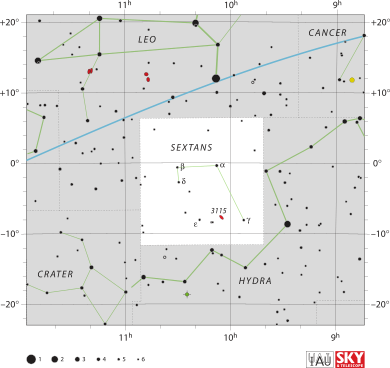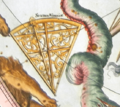Sextans facts for kids
| Constellation | |

List of stars in Sextans
|
|
| Abbreviation | Sex |
|---|---|
| Genitive | Sextantis, Sextansis |
| Pronunciation | genitive |
| Symbolism | the Sextant |
| Right ascension | 10 |
| Declination | 0 |
| Quadrant | SQ2 |
| Area | 314 sq. deg. (47th) |
| Main stars | 3 |
| Bayer/Flamsteed stars |
28 |
| Stars with planets | 5 |
| Stars brighter than 3.00m | 0 |
| Stars within 10.00 pc (32.62 ly) | 5 |
| Brightest star | α Sex (4.49m) |
| Messier objects | None |
| Meteor showers | Sextantids |
| Bordering constellations |
Leo Hydra Crater |
| Visible at latitudes between +80° and −90°. Best visible at 21:00 (9 p.m.) during the month of April. |
|
Sextans is a small constellation located in the southern sky. It is named after a sextant, which is a tool used by sailors and astronomers. A sextant helps measure the angle between two objects, like a star and the horizon. This helps people figure out their location.
Contents
About Sextans
Sextans is one of the 88 modern constellations. It is not very bright and can be hard to spot. It is often seen near the much larger constellation of Hydra, the sea serpent. Sextans is part of the Hercules Family of constellations.
Who Discovered Sextans?
The constellation Sextans was created by a Polish astronomer named Johannes Hevelius. Hevelius lived in the 17th century. He named it "Sextans Uraniae," which means "the Sextant of Urania." Urania was the Greek goddess of astronomy. Hevelius named it after his own astronomical sextant. This tool was destroyed in a fire in 1679.
Where to Find Sextans
Sextans is located near the celestial equator. This is an imaginary line in the sky, like Earth's equator. Because of its position, people can see Sextans from most places on Earth. It is best seen in the spring months, especially in April. You can find it between the constellations of Leo (the Lion) and Hydra (the Sea Serpent). It also borders Crater (the Cup).
Stars and Objects in Sextans
Sextans does not have many bright stars. Its brightest star is called Alpha Sextantis (α Sex). This star is not very bright, with a magnitude of about 4.49. The lower the number, the brighter the star. This means Alpha Sextantis is just barely visible to the naked eye from dark locations.
Other Stars
There are a few other stars in Sextans that have planets orbiting them. This means there are other solar systems in this constellation! One of the closest stars to Earth in Sextans is LHS 292. It is about 14.8 light-years away. A light-year is the distance light travels in one year.
Deep-Sky Objects
Sextans does not contain any Messier objects. Messier objects are a famous list of nebulae, galaxies, and star clusters. However, it does have some interesting galaxies that can be seen with telescopes. These include the Sextans A and Sextans B galaxies. They are dwarf galaxies, which are smaller galaxies.
Meteor Showers
Sextans is also home to a meteor shower called the Sextantids. Meteor showers happen when Earth passes through a trail of dust left by a comet. The dust burns up in our atmosphere, creating streaks of light. The Sextantids are a minor meteor shower. They are visible in late September and early October.
Images for kids
-
The constellation Sextans as depicted in Johann Doppelmayr's Atlas Coelestis, c. 1730 (Plate 19, Southern Celestial Hemisphere).
See also
 In Spanish: Sextans para niños
In Spanish: Sextans para niños


